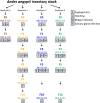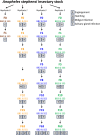Infectivity of Plasmodium parasites to Aedes aegypti and Anopheles stephensi mosquitoes maintained on blood-free meals of SkitoSnack
- PMID: 38971776
- PMCID: PMC11227701
- DOI: 10.1186/s13071-024-06364-9
Infectivity of Plasmodium parasites to Aedes aegypti and Anopheles stephensi mosquitoes maintained on blood-free meals of SkitoSnack
Abstract
Background: Aedes and Anopheles mosquitoes are responsible for tremendous global health burdens from their transmission of pathogens causing malaria, lymphatic filariasis, dengue, and yellow fever. Innovative vector control strategies will help to reduce the prevalence of these diseases. Mass rearing of mosquitoes for research and support of these strategies presently depends on meals of vertebrate blood, which is subject to acquisition, handling, and storage issues. Various blood-free replacements have been formulated for these mosquitoes, but none of these replacements are in wide use, and little is known about their potential impact on competence of the mosquitoes for Plasmodium infection.
Methods: Colonies of Aedes aegypti and Anopheles stephensi were continuously maintained on a blood-free replacement (SkitoSnack; SS) or bovine blood (BB) and monitored for engorgement and hatch rates. Infections of Ae. aegypti and An. stephensi were assessed with Plasmodium gallinaceum and P. falciparum, respectively.
Results: Replicate colonies of mosquitoes were maintained on BB or SS for 10 generations of Ae. aegypti and more than 63 generations of An. stephensi. The odds of engorgement by SS- relative to BB-maintained mosquitoes were higher for both Ae. aegypti (OR = 2.6, 95% CI 1.3-5.2) and An. stephensi (OR 2.7, 95% CI 1.4-5.5), while lower odds of hatching were found for eggs from the SS-maintained mosquitoes of both species (Ae. aegypti OR = 0.40, 95% CI 0.26-0.62; An. stephensi OR = 0.59, 95% CI 0.36-0.96). Oocyst counts were similar for P. gallinaceum infections of Ae. aegypti mosquitoes maintained on SS or BB (mean ratio = [mean on SS]/[mean on BB] = 1.11, 95% CI 0.85-1.49). Similar oocyst counts were also observed from the P. falciparum infections of SS- or BB-maintained An. stephensi (mean ratio = 0.76, 95% CI 0.44-1.37). The average counts of sporozoites/mosquito showed no evidence of reductions in the SS-maintained relative to BB-maintained mosquitoes of both species.
Conclusions: Aedes aegypti and An. stephensi can be reliably maintained on SS over multiple generations and are as competent for Plasmodium infection as mosquitoes maintained on BB. Use of SS alleviates the need to acquire and preserve blood for mosquito husbandry and may support new initiatives in fundamental and applied research, including novel manipulations of midgut microbiota and factors important to the mosquito life cycle and pathogen susceptibility.
Keywords: Plasmodium falciparum; Plasmodium gallinaceum; Insect rearing; Malaria transmission; Vector-borne disease.
© 2024. This is a U.S. Government work and not under copyright protection in the US; foreign copyright protection may apply.
Conflict of interest statement
All authors declare no conflicts of interest.
Figures




Similar articles
-
The dynamics of interactions between Plasmodium and the mosquito: a study of the infectivity of Plasmodium berghei and Plasmodium gallinaceum, and their transmission by Anopheles stephensi, Anopheles gambiae and Aedes aegypti.Int J Parasitol. 2003 Aug;33(9):933-43. doi: 10.1016/s0020-7519(03)00112-7. Int J Parasitol. 2003. PMID: 12906877
-
The role of the mosquito peritrophic membrane in bloodmeal digestion and infectivity of Plasmodium species.J Parasitol. 1992 Jun;78(3):430-40. J Parasitol. 1992. PMID: 1597785
-
Vector competence of Aedes albopictus (Skuse) and Aedes aegypti (Linnaeus) for Plasmodium gallinaceum infection and transmission.Vet Parasitol. 2017 Jul 15;241:20-25. doi: 10.1016/j.vetpar.2017.05.002. Epub 2017 May 8. Vet Parasitol. 2017. PMID: 28579025
-
Systematic review of sporozoite infection rate of Anopheles mosquitoes in Ethiopia, 2001-2021.Parasit Vectors. 2023 Nov 27;16(1):437. doi: 10.1186/s13071-023-06054-y. Parasit Vectors. 2023. PMID: 38008761 Free PMC article. Review.
-
Controlling malaria transmission with genetically-engineered, Plasmodium-resistant mosquitoes: milestones in a model system.Parassitologia. 1999 Sep;41(1-3):461-71. Parassitologia. 1999. PMID: 10697903 Review.
References
-
- Spielman A. Mosquito: a natural history of our most persistent and deadly foe. 1. New York: Hyperion; 2001.
MeSH terms
Grants and funding
LinkOut - more resources
Full Text Sources

